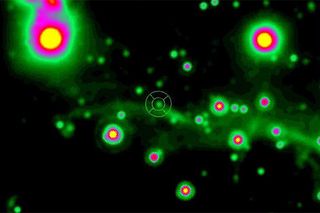Black Hole's Rejected Snack Becomes Science Goldmine

Remember that mysterious cloud of gas that was supposed to be on a collision course with the supermassive black hole in the center of our galaxy? Well, astronomers are still trying to work out why it wasn’t sucked in, and why it didn’t spark the mother of all cosmic fireworks displays.
But in doing so, researchers have revealed some fascinating new things about the monster singularity that lurks over 25,000 light years from Earth.
ANALYSIS: Did Mystery Object Rumble Our Monster Black Hole?
In 2011, astronomers noticed a cloud of gas speeding through the innermost reaches of the galactic bulge. Ahead of the object, known (rather un-romantically) as “G2″, was supermassive black hole Sagittarius A* (or, simply, Sgr A*). After some caluculations, it was realized that this cloud would come within 250 sun-Earth distances of the black hole, close enough to be sucked in by the black hole’s powerful gravitational pull.
This was really exciting: for the first time in human history we’d be able to study material before it fell into a black hole, from approach to dazzling finale.
At the time, it was assumed G2 was composed of a nebulous collection of stellar gases. It was also assumed that, while undergoing extreme tidal warping, the cloud would be stretched out like a long noodle, with tendrils being sucked into the black hole’s accretion disk. Somewhere along the line it was hoped that the emissions from knots of this gas interacting with the extreme spacetime environment surrounding Sgr A*’s event horizon would be detected as X-ray flashes — possibly the biggest eruptions we’d ever see come from Sgr A*. We’d witness our black hole in action; from discovery of an in-falling object to that object’s ultimate doom — when matter gets transformed to energy and the black hole has a cosmic feast.
ANALYSIS: Our Galaxy’s Black Hole Does NOT Have the ‘Munchies’
Get the Space.com Newsletter
Breaking space news, the latest updates on rocket launches, skywatching events and more!
But… nothing happened.
Well, stuff did happen, but the destruction of G2 became something of a non-event and astrophysicists have been trying to work out exactly what happened… or, more accurately, why something didn’t happen.
The current hypothesis is that G2 isn’t the loose collection of gas it was assumed to be; it could be a star enveloped in a cloud of gravitationally-bound gas. During its close encounter with Sgr A*, the cloud maintained its integrity and very little gas was stripped away from the cloaked star. No infalling matter; no cosmic fireworks; disappointed astronomers.
In new research published in the journal Monthly Notices of the Royal Astronomical Society (MNRAS), astronomers Michael McCourt and Ann-Marie Madigan of the Harvard-Smithsonian Center for Astronomy (CfA) described their study of G2, revealing that although it was a bit of a dud, the event did probe the extreme environment surrounding Sgr A*. Of particular interest: they may have tracked down where the black hole finds its regular feast.
ANALYSIS: Our Galaxy’s Black Hole Has the ‘Munchies’
McCourt and Madigan tracked G2, and another gas cloud called “G1″, travel through the vicinity of Sgr A*. It just so happens that the clouds passed so close, that they would have traveled through the black hole’s “accretion flow” — in other words, these clouds could be used as tracers to see the structure of the matter that regularly falls into the black hole.
As both clouds follow a similar trajectory around the black hole, small changes in the objects’ gas could be measured. And the evolution of these clouds revealed characteristics of the interstellar material surrounding Sgr A*.
“Although it is not yet clear whether these objects contain embedded stars, their extended gaseous envelopes evolve independently as gas clouds,” they write. “We find evolution consistent with the G-clouds (G1 and G2) originating in the clockwise disc. Our analysis enables the first unique determination of the rotation axis of the accretion flow: we localize the rotation axis to within 20 degrees, finding an orientation consistent with the parsec-scale jet identified in X-ray observations and with the circumnuclear disc, a massive torus of molecular gas (approximately) 1.5 parsecs (5 light-years) from Sgr A*.”
ANALYSIS: Event Horizon Telescope Will Probe Spacetime’s Mysteries
Basically, observations of G1 and G2 show the direction that material travels as it falls into the black hole, thereby tracing out the rotation of the black hole’s accretion disk. Also, they found that rather than the black hole being fed by the stellar winds of nearby stars, material is being pulled from a massive ring of material, some 5 light-years away.
So G2 didn’t spark the exciting eruption of flares and X-ray emissions that astronomers predicted in 2011, but it turns out that G2 (and it’s orbiting buddy G1) have been far more useful in not being eaten by the black hole; instead being flung around the center of the galaxy, providing tantalizing clues as to the nature of the gravitational monster living in the center of the Milky Way.
Source: CfA
Originally published on Discovery News.
Join our Space Forums to keep talking space on the latest missions, night sky and more! And if you have a news tip, correction or comment, let us know at: community@space.com.
Ian O'Neill is a media relations specialist at NASA's Jet Propulsion Laboratory (JPL) in Southern California. Prior to joining JPL, he served as editor for the Astronomical Society of the Pacific‘s Mercury magazine and Mercury Online and contributed articles to a number of other publications, including Space.com, Space.com, Live Science, HISTORY.com, Scientific American. Ian holds a Ph.D in solar physics and a master's degree in planetary and space physics.
